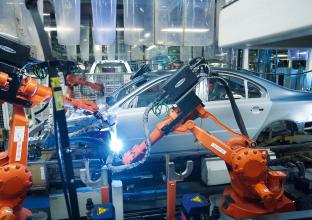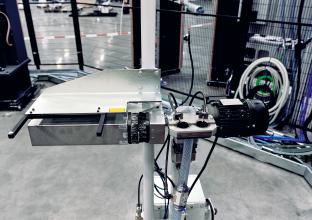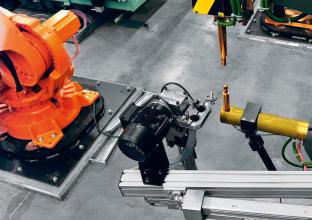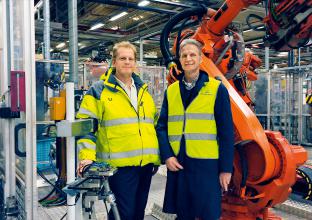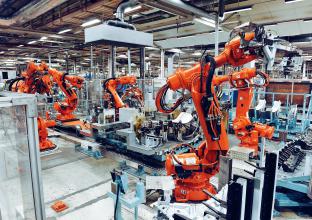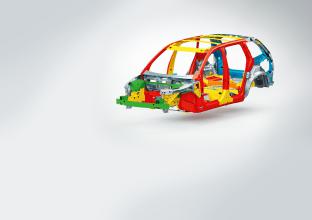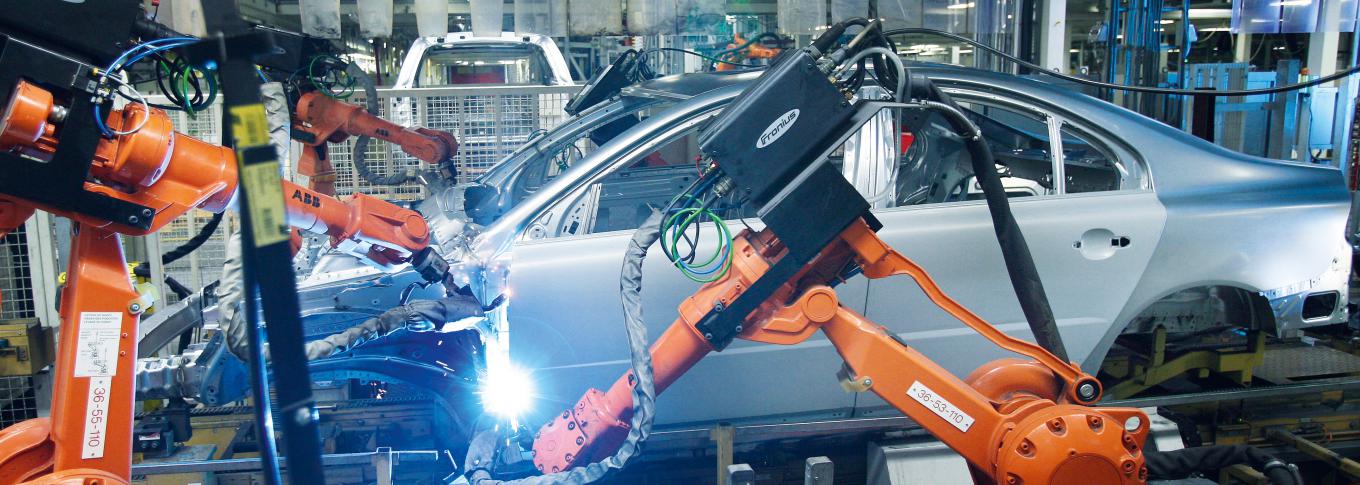
A Swedish recipe that really hits the spot
The fact that spot welding is becoming ever faster and more reliable is illustrated by a customer-specific solution installed at Volvo in Sweden. The ingredients of this special Swedish recipe are electric drive technology and vision systems from Festo, linked to the automation platform CPX. This means more reliability in the production of the sheet-metal components for Volvo car bodies, and more safety for the plant operators.
Hidden in a picturesque landscape between lakes and surrounded by forests is the south Swedish town of Olofström – approximately two hours from the international air traffic hub of Copenhagen. Here, away from the industrial centres of Stockholm, Gothenburg and Malmö, lies the most important bodywork plant of the Volvo group. Today, five trains with 280 containers full of car body parts leave Olofström every day, heading for the Volvo assembly plants in Gothenburg and Ghent, Belgium, where they are assembled to form complete bodies. This amounts to 50 million components annually.
Competency in spot welding
“Most of what you can see of a Volvo comes from Olofström,” explains Leif Winberg, the plant engineer in charge of resistance welding in the Volvo Olofström factory. This includes load-bearing components like the A, B and C columns, the bumper reinforcement, the front side members, the side impact beams, the cross beams and the roof arch and roof rail, together with doors and frames. All these components are produced in different versions for the various Volvo models, ranging from the compact V40 through to the S60 saloons and the large SUV with the name XC90.
A key element in bodywork production is resistance welding, since correctly welded sheet metal components play a crucial role in the passive safety of a vehicle. Within the welding process, there is great potential for increased productivity in the milling of electrodes. The electrodes of welding guns become blunter as they are used to make spot welds and must therefore be milled after approximately 150 spot welds so that they once again enable accurate spot welding. “Electrode milling operates on the same principle as the sharpening of a blunt pencil,” explains welding expert Winberg.
Joint development
“In recent years we have found solutions which have enabled us to cut the cycle times for electrode milling by well over half,” continues Winberg. “There is also a gain in safety, since plant operators no longer have to enter the robot cells after milling in order to adjust the electrodes to the correct position for the spot welds,” adds Leif Lindahl, former Business Development Manager Automotive with Festo Sweden.
For static welding guns, Festo developed a customised pivot arm exactly as per the specifications of Volvo and ABB which brings the electrode milling device, the so called tip dresser, to the electrodes after 150 spot welds have been completed. The pivot arm is precisely positioned by Festo electric cylinders DNCE. Thanks to freely programmable positions, these electric cylinders are flexible in terms of motion and accelerate gently. The complete ready-to-install electrical package supplied by Festo includes stepper motor EMMS and motor controller CMMS. The motor controllers are safely integrated in a control cabinet with the automation platform CPX. The CPX communicates with the motor controllers and with the master control system for the robot installation via Profinet.
Electrode milling controlled by vision system
Mobile tip dressers are not necessary for the welding guns on the ABB articulated robots. These robots can feed their electrodes themselves to the electrode milling device after 150 spot welds. This freedom of movement of the welding guns opens completely new horizons. In a first step, the articulated robot brings the welding gun to the tip dresser. This then mills the electrodes. In the next step, the robot swings its electrodes in front of the lens of the Festo vision system SBO…-Q.
“The system produces an image which supplies the robot system with all the data necessary in order to position the electrodes correctly to weld the next sheet metal components,” says Winberg. “The vision system is also easy to integrate and simple to commission via parameterisation.” The system includes not only the sensor system for the acquisition of image data but also a complete electronic evaluation unit and the interfaces (Ethernet/CAN) required for communication with higher-level controllers (PLCs). The vision system itself is accommodated in a housing which is no bigger than a one-litre carton of milk.
Cycle times reduced to a quarter
In a fraction of a second, the image from the vision system provides data on the alignment of the contact surface, the length and angle of the electrode and the starting point on the sheet metal. The vision system sends this data to the robot controller, which sets the robot for the next spot welds. “This has allowed us to reduce the cycle times for electrode milling from 35 seconds to just nine seconds,” says Winberg enthusiastically about the new system. “This means that we can almost achieve the same cycle time as a machining rotary indexing table, which is six seconds.” Considering that there are 300 welding robots installed in Olofström, this marks a further milestone in the hunt for shorter cycle times and thus higher productivity.
Festo is a global player and an independent family-owned company with headquarters in Esslingen am Neckar, Germany. Festo has set standards in industrial automation technology and technical education ever since its establishment, thereby making a contribution to sustainable development of the environment, the economy and society. The company supplies pneumatic and electrical automation technology to 300,000 customers of factory and process automation in over 35 industries. Digitalization, AI and the LifeTech sector with medical technology and laboratory automation are becoming increasingly important. The products and services are available in 176 countries. With about 20,800 employees in over 250 branch offices in around 60 countries worldwide, Festo achieved a turnover of around €3.81 billion in 2022. Each year around 7% of this turnover is invested in research and development. In this learning company, 1.5 % of turnover is invested in basic and further training. Festo Didactic SE is a leading provider of technical education and training and offers its customers worldwide comprehensive digital and physical learning solutions in the industrial environment.

